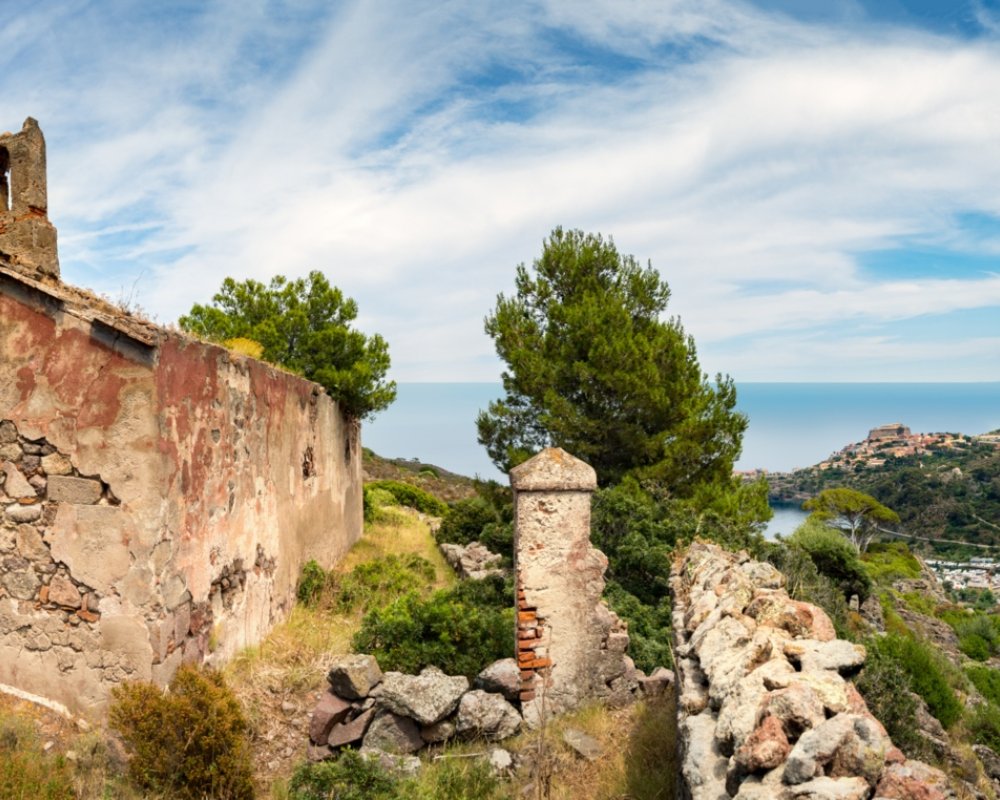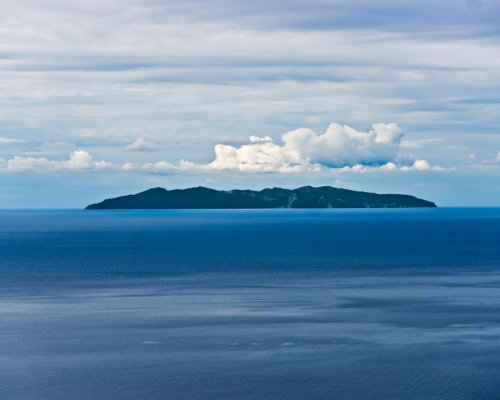


A circular route for discovering the nature and history of the western-most island in the Tuscan Archipelago
Capraia is a small paradise of nature conserved thanks to its original use as a farming penal colony and later, after the prison was closed, to the protection guaranteed by the Arcipelago Toscano National Park. This has allowed for the small, western-most island in the archipelago to be preserved. Closer to Corsica than the mainland, Capraia is at the centre of an area known as the Cetacean Sanctuary, with coasts jutting out into the crystal-clear waters.
Though small, Capraia is perfect for hiking enthusiasts. Peaks, rocky ridges, valleys and canyons make it the ideal terrain for hikers, who can tackle trails with varying levels of difficulty. Whether starting from the town or the port, you can explore these highly interesting paths. Walk through the Mediterranean scrub, with its fragrances and colours: heather, myrtle, orchids and water plants in the Stagnone dot the way and offer relief during breaks. You can climb the highest peaks or walk along the ridge as you take in the cliffs that hang over the sea and stop to admire hidden corners and the bays that line the coast.
Walk in silence, interrupted only by the wind and the sounds of the sea or when you meet the island’s quiet locals: it’s common to run into wild rabbits and sheep, tree frogs and migratory birds on the banks of the Stagnone. To walk this island means to walk through history, from the trails, which are often ramparts dating to the Napoleonic era, to the ancient Roman settlement of Piano to the abandoned penal colony, with its buildings that speak of the history of the prisoners held in this small paradise.
Our walk begins in the town centre, from where you’ll head upward following the via del Semaforo. Continue until you reach the Piano, an ancient Roman settlement and which still today is embellished with vineyards; the location is perfect for delicate and fragrant wines thanks to the island’s hills and Mediterranean climate. History guides you along the way, through the ramparts built during the Napoleonic era and which are today the trails you’re walking on. When you reach the crossroads, follow directions for the Stagnone.
The climb is surrounded by Mediterranean aromas, heather and strawberry trees. You’ll come to the Acciattore Pass, boasting an unforgettable view of the western coast. From here, you can clearly see the outline of Corsica, which Capraia is closer to than the Tuscan coast. Asphodelus and rosemary plants remind you that you’re in the heart of the Mediterranean. Near the Pass, you’ll find a small field with curious circles made of little stones, traces of ancient rituals that we don’t know much about today. Rest for a while as you gaze at the deep blue of the Tyrrhenian sea before setting off again.
Our walk begins in the town centre, from where you’ll head upward following the via del Semaforo. Continue until you reach the Piano, an ancient Roman settlement and which still today is embellished with vineyards; the location is perfect for delicate and fragrant wines thanks to the island’s hills and Mediterranean climate. History guides you along the way, through the ramparts built during the Napoleonic era and which are today the trails you’re walking on. When you reach the crossroads, follow directions for the Stagnone.
The climb is surrounded by Mediterranean aromas, heather and strawberry trees. You’ll come to the Acciattore Pass, boasting an unforgettable view of the western coast. From here, you can clearly see the outline of Corsica, which Capraia is closer to than the Tuscan coast. Asphodelus and rosemary plants remind you that you’re in the heart of the Mediterranean. Near the Pass, you’ll find a small field with curious circles made of little stones, traces of ancient rituals that we don’t know much about today. Rest for a while as you gaze at the deep blue of the Tyrrhenian sea before setting off again.
Leave the Acciattore Pass behind you and continue your walk through the Mediterranean scrub. The silence is broken only by the sounds of the wind and the sea breaking on the cliffs. It’s not uncommon for hikers to come across wild rabbits and sheep.
You’ll eventually come to the small lake known as Stagnone, a reservoir that fills between autumn and spring and which in the summer months is dotted all around with white ranunculus aquatilis, a common water flower, and mint plants. The Stagnone is the only natural reservoir in the Tuscan Archipelago. In addition to being home to a rich and colourful ecosystem, the lake is found along the migratory routes for many species of birds moving from the north to Africa, becoming a stopping point for many of them, which makes it the ideal place for birdwatching enthusiasts. You might even spot some small Sardinian tree frogs hiding amongst the rocks and aquatic plants.
Continue further on and take a path that branches off from the eastern bank and winds 420 metres up Monte Le Penne. From here, you can enjoy a 360° view of Corsica and the other islands in the archipelago, as well as Capraia’s cliffs. Stop here before moving on.
Leave the Acciattore Pass behind you and continue your walk through the Mediterranean scrub. The silence is broken only by the sounds of the wind and the sea breaking on the cliffs. It’s not uncommon for hikers to come across wild rabbits and sheep.
You’ll eventually come to the small lake known as Stagnone, a reservoir that fills between autumn and spring and which in the summer months is dotted all around with white ranunculus aquatilis, a common water flower, and mint plants. The Stagnone is the only natural reservoir in the Tuscan Archipelago. In addition to being home to a rich and colourful ecosystem, the lake is found along the migratory routes for many species of birds moving from the north to Africa, becoming a stopping point for many of them, which makes it the ideal place for birdwatching enthusiasts. You might even spot some small Sardinian tree frogs hiding amongst the rocks and aquatic plants.
Continue further on and take a path that branches off from the eastern bank and winds 420 metres up Monte Le Penne. From here, you can enjoy a 360° view of Corsica and the other islands in the archipelago, as well as Capraia’s cliffs. Stop here before moving on.
From Monte Le Penne, continue along a path that winds once more through the fragrant Mediterranean scrub and which runs along the base of Monte Castello, the highest on the island. Head down through the areas that once belonged to the penal colony, which closed in 1986 after nearly 100 years of activity. Walk through the prison’s abandoned buildings as you try to imagine what day-to-day life was like in this small fortified colony. You’ll come across the Aghiale, with the cells, housing for the guards, dining hall, barber and sheep pen, where the inmates carried out the colony’s typical farming activities, as well as the ruins of the former laundry. It should be said that the buildings belonging to the ex-penal colony are in a state of near or total abandon, and some of them, having been built at the end of the 1800s, were already not in the best condition when the colony closed down. Visitors are advised to take caution when exploring the ruins and to respect no entry signs.
Leave behind the former penal colony, passing through the arch that marks the entrance. From here, the fragrances of heather and Mediterranean scrub accompany you on your return to the port and the town.
From Monte Le Penne, continue along a path that winds once more through the fragrant Mediterranean scrub and which runs along the base of Monte Castello, the highest on the island. Head down through the areas that once belonged to the penal colony, which closed in 1986 after nearly 100 years of activity. Walk through the prison’s abandoned buildings as you try to imagine what day-to-day life was like in this small fortified colony. You’ll come across the Aghiale, with the cells, housing for the guards, dining hall, barber and sheep pen, where the inmates carried out the colony’s typical farming activities, as well as the ruins of the former laundry. It should be said that the buildings belonging to the ex-penal colony are in a state of near or total abandon, and some of them, having been built at the end of the 1800s, were already not in the best condition when the colony closed down. Visitors are advised to take caution when exploring the ruins and to respect no entry signs.
Leave behind the former penal colony, passing through the arch that marks the entrance. From here, the fragrances of heather and Mediterranean scrub accompany you on your return to the port and the town.